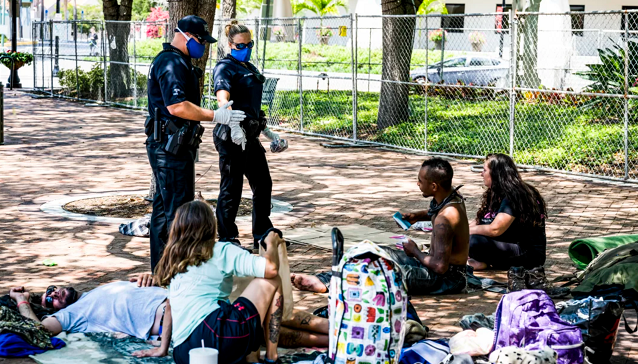How To Beat Homelessness: Sarasota, Florida vs. Los Angeles, California

It seems like a strange matchup, a midsize community against one of the world’s great cities — or once great cities. Other than being in the United States and never seeing snow, there are not a lot of similarities between Los Angeles and Sarasota, Florida.
Except about 10 years ago, they both, like most American cities, were facing an increasing homeless problem. The warmth of southern cities, particularly Florida cities, is a major attraction for everyone, and as it turns out there are homeless snowbirds, of a sort.
But Sarasota and L.A. took two opposite paths in dealing with the problem. L.A., like many progressive cities, turned to a mix of homelessness or housing as a human right and pursued a “housing first” concept. Any program that got keys into the hands of the homeless quickly under “rapid housing” was pursued with gushers of taxpayer money — without regard to what had caused people to become homeless in the first place.
At the same time, those progressive cities — San Francisco, Portland and Seattle stand out with L.A. but there are many others — hamstrung attempts by law enforcement and business owners to remove the homeless from badgering patrons and threatening people or just urinating or defecating at their front door. “Homelessness is not a crime!” they cried emotionally. But what they meant was that the homeless committing crimes was not a crime.
We’ve all seen the results of these policies. Massive tent cities in L.A. where the homeless population is estimated to be 80,000 strong and is one of many factors contributing to people fleeing the once City of Angels. They have swelled into the suburbs, too, leaving fewer people feeling safe if they don’t live behind walled mansions with armed guards, such as the Hollywood elite who, bubbled away from impact on themselves, self-righteously push for the destructive progressive policies.
Sarasota took a different approach, one advocated by Robert Marbut, a consultant at the time he was hired by Sarasota in 2013, and who was later tapped by President Donald Trump to be the executive director of the U.S. Interagency Council on Homelessness — the homelessness czar.
Sarasota officials — and importantly, private institutions and organizations — followed many, not all, of Marbut’s advice to target the root cause of the homeless, seeing the homelessness as a symptom of a deep underlying problem with the individuals that normally falls into the categories of drug and alcohol addiction and mental health issues. This is undeniably true.
Statistics are notoriously tricky on the homeless for obvious reasons. But numerous studies have found that somewhere between 20 and 40 percent of all homeless people have a severe mental illness, while another 15 to 40 percent suffer from chronic substance abuse. Large percentages also have spent significant time in prison and many have a disability. Despite these ranges, it’s easy to see that the vast majority of homeless people are not those who were “down on their luck” but otherwise fine, they lost their job and were evicted.
That’s why attacking those foundational causes of homeless is the only realistic and compassionate long-term solution.
So the Sarasota community, both the city and county working together, got rid of the homeless camps that had sprouted up, pursued treatment programs and ensured interagency cooperation that is often lacking, making sure the homeless received help with their underlying problems, their root causes, and then got help getting back on their feet with training and housing.
The Gulf Coast Community Foundation and other nonprofits in the Sarasota region work closely with the Sarasota County School District to make sure young people and their families get connected with social services and housed quickly while often requiring treatment of the underlying problems. Marbut calls this work the “most innovative youth programming in America.”
The result is that the Sarasota area’s “unsheltered homeless” population — those who do not have a permanent residence but are in shelters or other facilities — has fallen almost in half in the past four years.
It shows on the streets. Downtown Sarasota, considered one of the most thriving mid-sized downtowns in the country, was dealing with constant homeless problems a decade ago. It was the top story and the biggest issue for downtown business establishments. But it rarely makes any news now.
Like everywhere, Sarasota still has to deal with groups that the media likes to call “homeless advocates,” but which actually end up advocating for people being homeless through their poorly thought-out solutions. But the public sees the results. It is hard to argue with success. Treat the underlying causes of homelessness, not the symptom, through cooperative programs linking public and private agencies, schools and law enforcement. Common sense again offers up the best solution.
“Twice in the last week, when asked where is the best program in the country, I said Sarasota, Florida,” Marbut said recently.
EDITORS NOTE: This Revolutionary Act column is republished with permission. ©All rights reserved. Like Rod’s new Youtube channel. Follow Rod on Parler.


An excellent article but it didn’t name the real culprit among “homeless advocates” that is the permanent issue/constituency. Most of the highly publicized advocates are liberals in liberal cities interested in maintaining the issue – not finding a solution! It’s the same as the issue of minority poverty and will continue to be if Biden ever gets in the White House!